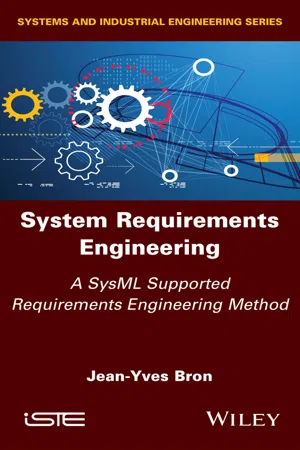
System Requirements Engineering
A SysML Supported Requirements Engineering Method
- English
- ePUB (mobile friendly)
- Available on iOS & Android
About This Book
The book deals with requirements engineering in the context of System Engineering. He proposes a method to guide this activity engineering. The method is supported by the SysML modeling language. A first chapter aims to present the context and the associated definitions, to position the requirements engineering in the processes system engineering, to define the modeling and its contributions, and to make the link with the management of IS projects. The second chapter is devoted to the proposed method for implementing the requirements engineering subprocesses. Each of the 8 activities the component is first described before specifying how the SysML language can be exploited to achieve it effectively. Proposal for a book Please fill out the questionnaire below and send it back to Chantal Menascé: [email protected] The 3rd chapter is an application of the method to define the needs of the stakeholders of a system. The example is built on the basis of the RobAFIS'2018 competition. The 4th chapter continues the application of the method in the continuity of the IS processes to define the requirements of the same system. The appendices present at the same time a toolbox to realize the engineering of the requirements but also the complete results of engineering in Chapters 3 and 4.
Frequently asked questions
Information
PART 1
Requirements Engineering
1
The Requirements Engineering Process
1.1. Background and main definitions
“An interdisciplinary approach governing the total technical and managerial effort required to transform a set of stakeholder needs, expectations, and constraints into a solution and to support that solution throughout its life.” [ISO 15a]
- – consider the system as a whole;
- – consider the entire life cycle of the system [ISO 19];
- – identify the interrelationships among the parts that compose it and also with the system environment.
- A statement that translates or expresses a need and its associated constraints and conditions – ISO 29148 [ISO 18b].
- A condition or capability that must be met or possessed by a system, system component, product, or service to satisfy an agreement, standard, specification, or other formally imposed documents – IEEE 730 [IEE 14].
- A provision that contains criteria to be fulfilled – ISO 14143 [ISO 07].
- A condition or capability that must be present in a product, service, or result to satisfy a contract or other formally imposed specification – Project Management Body of Knowledge IEEE 1490 [IEE 11].
“A requirement prescribes a property that is deemed necessary to obtain. Its statement can be a function, ability, characteristic or limitation that a system, product or process must satisfy.” [AFI 12a]
- – Specific:
- - Only one subject dealt with at a time, precision, rigor.
- - Unambiguous: only one possible interpretation.
- - Pure prescription: it concerns the “what” and not the “how”.
- – Measurable:
- - Verifiable, validable: methods exist to verify or validate it.
- – Achievable:
- - Feasible: with the state of the art, on the envisaged horizon.
- - Realistic: with the constraints of the project (deadline, cost, quality).
- – Relevant:
- - Consistency: no incompatible requirements.
- - Completeness: exhaustiveness without more/problem addressed.
- – Traceable:
- - Identified.
- - Referenced: origin, document, realization.
Table of contents
- Cover
- Table of Contents
- Foreword
- Preface
- PART 1: Requirements Engineering
- PART 2: Case Study, Application of the Method
- References
- Index
- End User License Agreement